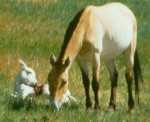
At Hustai National Park the Przewalski horses have to reckon with only one natural predator: wolves!
In the first years after the release into the wild wolf attacks were sparse. The first foal was killed in 1997. However, over the years the wolves have gained experience in wounding and killing of foals. Occasionally even an adult Przewalski horse did not survive the attack.
In the past years it happened that 20 – 25% of the new born foals was killed. During the first week of their lives the foals are the most vulnerable. Most foals are being born in May and June. It is around that time that the young wolves start prowling closely to their dens.
Partly due to its protected status the mountainous terrain makes ideal breeding ground for wolves. The local herdsmen, from the buffer zone of Hustai National Park, intensively pursue these very shy animals. Due to this shyness it is rather difficult to render estimations about the actual number of wolves in the Park. An estimation of 25 wolves appears to be the most plausible, which is much when we take in account that the wolves’ hunting-ground can measure up to hundreds of square kilometers.
The wolves, in and outside the Park, have been thoroughly studied by Mongolian biologists and students from the department for Nature Management of Wageningen University (Netherlands). Contact Hustai National Park for the reports.
L ocal herdsmen are being interviewed annually, carcasses localised and analysed. Through the means of faeces analysis the nourishing pattern of the wolves is extensively being examined. Sheep, goats and domestic horses of the nearby herdsmen are the main ingredients of their diet. The domestic horses graze freely, often at considerable distances away from the gers of the herdsmen, which turns them into relatively easy prey.
ocal herdsmen are being interviewed annually, carcasses localised and analysed. Through the means of faeces analysis the nourishing pattern of the wolves is extensively being examined. Sheep, goats and domestic horses of the nearby herdsmen are the main ingredients of their diet. The domestic horses graze freely, often at considerable distances away from the gers of the herdsmen, which turns them into relatively easy prey.
The preferred wild animals on the menu are tarbagans (big marmots) and marals (Mongolian roe deer). Research also revealed that Przewalski foals in harems that are staying nearby elevated forests or the bushy areas where the marals can be found, have a higher risk of being attacked by wolf. The strong growth in population have made the Przewalski horses to expand their range of distribution even into areas that they formerly were avoiding. It is in those wooded areas that the wolves are able to hide, undetected by the Przewalski horses, hindered in their sight by the thick foliage. A mare that just has foaled, strongly tends to guard her newly born against the others in the harem. When they wander too far off from the harem, they will become an easy prey. The stallion and mares are well able to resist the attackers, meanwhile forming a impenetrable ring around the foals.
Mostly the wolves will strike in the early morning or at dusk. In the period when most foals are born the Mongolian rangers, assisted by volunteers, will arrange extra nightly patrols. This appears to be effective: a much smaller number of foals are killed. In the current phase of Przewalski population building the staff of Hustai National Park wants to continue the implementation of those extra measures for a few more years
